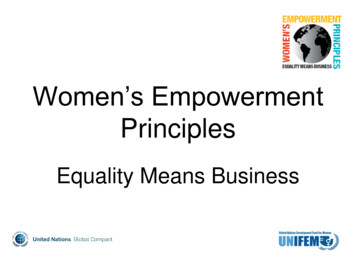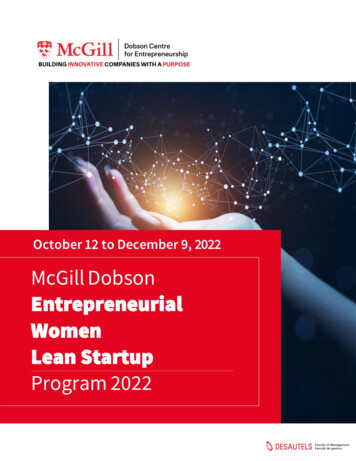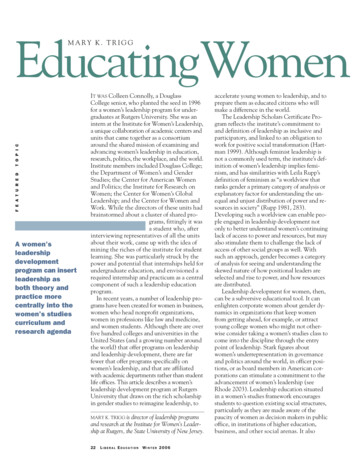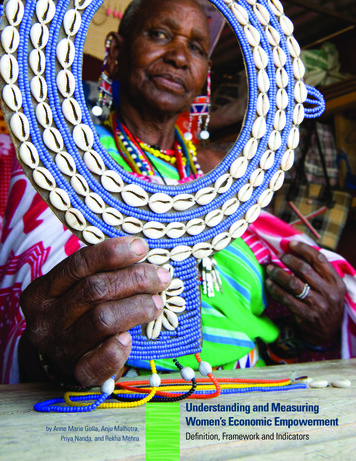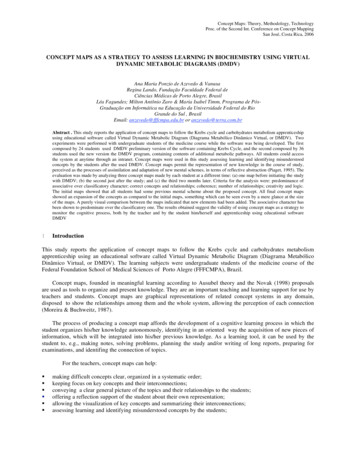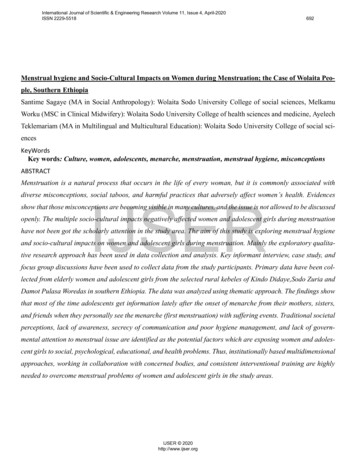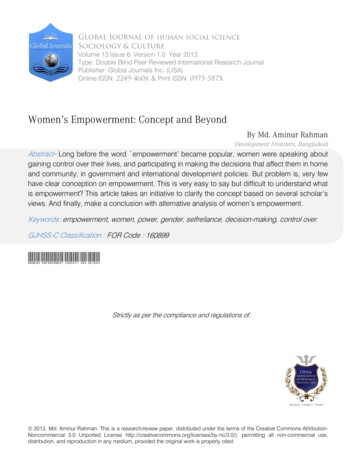
Transcription
Volume 13 Issue 6 Version 1.0 Year 2013Type: Double Blind Peer Reviewed International Research JournalPublisher: Global Journals Inc. (USA)Online ISSN:& Print ISSN:Women’s Empowerment: Concept and BeyondBy Md. Aminur RahmanDevelopment Frontiers, BangladeshAbstract- Long before the word empowerment’ became popular, women were speaking aboutgaining control over their lives, and participating in making the decisions that affect them in homeand community, in government and international development policies. But problem is, very fewhave clear conception on empowerment. This is very easy to say but difficult to understand whatis empowerment? This article takes an initiative to clarify the concept based on several scholar’sviews. And finally, make a conclusion with alternative analysis of women’s empowerment.Keywords : empowerment, women, power, gender, selfreliance, decision-making, control over.GJHSS-C Classification : FOR Code : 160899Womens Empowerment Concept and BeyondStrictly as per the compliance and regulations of: 2013. Md. Aminur Rahman. This is a research/review paper, distributed under the terms of the Creative Commons AttributionNoncommercial 3.0 Unported License http://creativecommons.org/licenses/by-nc/3.0/), permitting all non-commercial use,distribution, and reproduction in any medium, provided the original work is properly cited.
Women’s Empowerment: Concept and BeyondKeywords : empowerment, women, power, gender, selfreliance, decision-making, control over.TI.Introductionhe rise of gender sensitivity is one of thedistinguishing features of our times. It has takenhold human imagination like never before. For allpractical purposes, the concern of gender equity hasgraduated to the level of a policy objectives (Sharma :2000). Two perspectives have emerged in thecontemporary discourse on the modalities of erment. It is Easter Boserup’s (1970) pioneeringwork, Women’s Role in Economic Development thatpaved way to the rise of women’s developmentperspective. According to Sharma (2000;21), thedevelopment strategy, however, has come under severeinterrogation not only for its failure to deliver its promisebut also for working against the interest of womankind.Consequently, the decade of 90s has witnessed the riseof women’s empowerment perspective which shot intoprominence at Beijing Conference.As our experience, Paulo Freire (1996) in hisbook Padagogy of the Oppressed has discussed empowerment’ in a formal way for the first time in1970s. And after him, many scholars discussed it ashuman potential especially for women empowerment.Caroline Moser (1993), at first, discussed it asredistribution of power. But as a concept, empowerment’ is widely used, but seldom defined. Theoften-uncritical use of the term “empowerment” indevelopment thinking and practice disguises aproblematic concept. There is a room for greater clarityabout the concept and its application. Confusion ariseswith the concept empowerment because the rootconcept ‘power’ is itself disputed.Power has been thesubject of debate in social science. Some definitionsfocus, with varying degree of subtlety, on the availabilityAuthor : Research Fellow, Development Frontiers, Bangladesh.E-mail : dr.aminur65@gmail.comof one person to get another person or group to dosomething against their will. Such power is located indecision-making processes, conflict, and force, andcould be described as zero-sum; or the ‘power to createsuch relationship as love, respect friendship, legitimacyand so on. To try to come closer to an understanding ofempowerment we need to look at the actual meaning ofthe term that has been variously used by writers andresearchers, in a variety of context’ (Rowland, 1997).And let me attempt to discuss few concepts here onempowerment to understand the concept.Rawland’s (1997) view : According to Rawland,in order to understand the process of empowerment,there is a need to be aware that power can take manydifferent forms. Rawland explains :a. Power over: Controlling power, this may beresponded to with compliance, resistance on.b. Power to: Generative or productive power(sometimes incorporating or manifesting as forms ofresistance or manipulation) which creates newpossibilities and actions without domination.c. Power with: ‘a sense of the whole being greater thanthe sum of the individuals, especially when a grouptackles problems together’.d. Power from within: ‘the spiritual strength anduniqueness that resides in each one of us andmakes true human. Its basis is self-acceptance andself-respect, which extend, in turn, to respect forand acceptance of others as equals.Rawland have considered some of the differentmanifestations of power, we can return to the questionof what is meant by empowerment. Using theconventional definition, of “power over” empowermentmeans bringing people who are outside the decisionmaking process into it. This puts a strong emphasis onparticipation in political structures and formal decisionmaking and, in the economic sphere, on the ability toobtain an income that enables participation in economicdecision-making. Individuals are empowered when theyare able to maximize the opportunities available to themwithout constraints.Within the generative, ‘power to’ and “powerwith” interpretation of power, empowerment is concernwith the processes by which people become aware oftheir own interests how those relate to the interest ofothers in order both to participate from a position of agreater strength in decision-making and actually toinfluence such decisions. 2013 Global Journals Inc. (US)2092Global Journal of Human Social Science ( C ) Volume XIII Issue VI Version IAbstract - Long before the word empowerment’ becamepopular, women were speaking about gaining control overtheir lives, and participating in making the decisions that affectthem in home and community, in government and internationaldevelopment policies. But problem is, very few have clearconception on empowerment. This is very easy to say butdifficult to understand what is empowerment? This article takesan initiative to clarify the concept based on several scholar’sviews. And finally, make a conclusion with alternative analysisof women’s empowerment.Year 2013Md. Aminur Rahman
Year 2013Women’s Empowerment : Concept and BeyondFrom a feminist perspective, interpreting ‘powerover’ entails understanding the dynamics of oppressionand internalized oppressing. Empowerment is thus morethan participation in decision-making; it must alsoinclude the processes that lead people to perceivethemselves as able and entitled to make decisions. Asfeminist and other social theorist have shown, societiesascribe a particular set of abilities to social categories ofpeople. Empowerment must involve undoing negativesocial construction, so that people come to seethemselves as having the capacity and the right to actand influence decisions [Rowland, (1997).II.According to Rawland, empowerment to beoperating within three dimensions:a. Personal : development a sense of self andindividual confidence and capacity, and undoing thedefects of internalized oppression.b. Rational : developing the ability to negotiate andinfluence the nature of a relationship and decisionsmade within it.c. Collective : This includes involvement in politicalstructures, but might also cover collective actionbased co-operation rather than competition.The Three Dimensions of EmpowermentGlobal Journal of Human Social Science (C ) Volume XIII Issue VI Version elationship(Rowlands, Jo (1997) Questioning Empowerment, Oxford: Oxfam.)Naila Kabeer’s (1989) interpretation : Kabeerinterprets it as a redial transformation of power relationsbetween women and men ‘so that women have greaterpower over their own lives and men have less powerover women’s lives’. Kabeer (1994) has providedanother dynamic account of empowerment. She regardsempowerment as a concept with theoretical andpractical potential that merits being more than an emptyslogan.with an educational process (Naz :2006).In addition, Kabeer (1994) belief’s that selfesteem and feeling of being as active agent’ are thefundamental principles of empowerment and sheexpends her thought by saying that empowermentshould be considered aspect of perceiving oneself asan active agent capable of making decisions’(Naz;2006).Thus, it is not simply an act of decision makingShe found it necessary to deconstruct the but encompasses more. Kabeer does not ignore thenotion of power in order to consider empowerment. She value of collective action but considers it useful inexplained: ‘the multi-dimensional nature of power achieving social as well as political empowerment. In hersuggest that empowerment strategies for women must opinion, the empowerment process should have itsbuild on ‘the power within’ as a necessary adjunct to effect in policy changes at the state and marketimproving their ability to control resources, to determine institutions level that ultimately mould and limit women’sagendas and make decisions. Power from within needs live(Naz :2006).‘experiential recognition and analysis’ of issues to doJohn Friedman’s (1992) view : Friedman’swith women’s own subordination and how it is (1992: 32-34) theory of alternative development’ ismaintained. ‘Such power cannot be given; it has to be derived from the concept of empowerment that arisesself-generated (Kabeer: 1994). She emphasizes the from indigenous, political and social cultures of society.importance of such elements as self-respect, and the According to Friedman, There are three kinds of power,sense of agency. Careful analysis and insightful social, political and psychological. Social powerreflections are necessary preconditions for creation of consists in processing knowledge, information andnew form of consciousness. This idea is based on skills. Political power is a mechanism that influencesPaulo Freire’s conception of critical consciousness’ policy changes both at the micro and macro level. It’swhere the process of empowerment is bound up the result of the power of voice and collective action. 2013 Global Journals Inc. (US)
When we observes S. Batliwala (1993)observation, where she says the word “power” iscontained within the term empowerment implying thatempowerment is about changing the balance of powerin a given society, power being defined as control overresources and ideology. The resources may becategorized into physical, human, intellectual, financial,and self, including self-esteem, confidence, andcreativity. Ideology refers to beliefs, values, attitudes,and ways of thinking and perceiving situations. Shepoint out that empowerment is a process that involves aredistribution of power, particularly within the household.So power, power redistribution and powerrelationship are emphasized by the modern scholarswhen they have made clarification.Regarding empowerment, Hashemi et el (1993)have clarified it in a study ‘Targeted Credit Programsand the Empowerment of Women in Rural Bangladesh’and emphasized on women control over on her lives.They have identified six general domains in which,traditionally subordination of women is played out and inwhich empowerment of women is believed to be takingplace. The six domains are: 1.Sense of self and vision ofa future. 2. Mobility and visibility. 3. Ability to earn aliving. 4. Decision-making power within the household.5. Ability to interact effectively in the public sphere. 5.Participation in non- family groups. In another study of‘Rural Credit Programs and Women’s Empowerment inBangladesh’ Syed Hashemi et al (1996) have developedeight empowerment indicators to measure women’sempowerment especially for Bangladesh context as adeveloping country. And his conceptualisation is highlypraised in women development area. The eightindicators are: a. Mobility b. Economic security c. Abilityto make small purchases d. Ability to make largerpurchases e. Involvement in major decisions f. Relativefreedom from domination by the family g. Political andlegal awareness h. Participation in public protests andpolitical campaigning.And once it has found, scholars has analysesempowerment through gender lens and establish it forjudging women development. Though it is very difficultto differentiate real boarder line between developmentand empowerment. It has also found in Chen andMahmud’s (1995) clarification when they haveconceptualized also empowerment as women’sadvancement. As Chen and Mahmud (1995)Empowerment is a process of positive changethat improves women’s fallback position and bargainingpower within a patriarchal structure, and identify differentcausal pathways of change; material, cognitive,perceptual and relational.In short, empowerment is a process ofawareness and capacity building leading to greaterparticipation, to greater decision-making power andcontrol, and to transformative action. In addition,empowerment is a process that is both individual and 2013 Global Journals Inc. (US)20211Global Journal of Human Social Science ( C ) Volume XIII Issue VI Version IFinally, psychological power is expressed as anindividual sense of potency demonstrated in selfconfidence behaviour, self-reliance and increased selfesteem. Friedman explains empowerment as socialpower, which can be translated into political power.Social networking enhances their position and power,which consequently expedites and strengthens theprocess of psychological, social and politicalempowerment.According to kate Young (1993), empowermentenables women to take control of their own lives, settheir own agenda, organize to help each other andmake demands on the state for support and on thesociety itself for change’.As Young, empowerment is a complete changeof the processes and structures responsible forwomen’s inferior status in the society. It is based on a transformatory potential’ related to the need totransform women’s position in such a way that theadvancement will be sustained. Finally, she summarizesthe concept of empowerment from individual to widerpolitical perspectives and she puts sufficient importanceto collective action, as it is a sure means to individualempowerment.In true sense, this term is discussed as feministperspective, and Marilee Karl (1995) says, ‘The word‘Empowerment’ captures this sense of gaining control,of participation in decision-making. More recently, theword has entered the vocabulary of developmentagencies, including international organizations and theUnited Nations’. And Vanessa Griffen (1987) explains italso through gender lens, as her, empowerment means. having control, or gaining further control; having a say and being listened to; being able to define and create from a women’sperspective;being able to influence social choicesand decisions affecting the whole society (not justareas of society accepted as women’s place) being recognized and respected as equal citizensand human beings with a contribution to make.And again Beteille (1999:591), discusses it aspower distribution without having clear power.According to berteile, ‘the main point behindempowerment is that it seeks to change society througha rearrangement of power’.It reflects the kabeer’s opinion. But, Dandikar(1986:26) has described empowerment as amultifaceted process, which involves four parallelaspects. These are: The women’s economic/resource base; The public/political arena allowed to her by society; Her family structure, and the strength and limitationsit imposes on her; and Perhaps most important, the psychological /ideological “sense” about women in her society,which in turn shapes her own perception of herselfand the options she allows herself to consider.Year 2013Women’s Empowerment : Concept and Beyond
Women’s Empowerment : Concept and Beyondcollective. Sometimes it involve people as groups thatmost often begin to develop their awareness and theability to organize to take action and bring aboutchange.Year 2013III.Global Journal of Human Social Science (C ) Volume XIII Issue VI Version I20212Alternative Thought as BeyondToday, when empowerment approach isreigning supreme, there is need for a cool anddispassionate scrutiny of some of its infirmities. In theinterest of systematic scrutiny, I explain it through liberal,structural and cultural perspectives.Viewed from liberal perspective, women’sempowerment approach suffers from three fallacies:exclusionary bias, adversarial orientation and subversivelogic (Sharma: 2000:21). It suffers from an exclusionarybias in that it excludes man from the feminist discourse,organisation and movement. It is noticed, it isolateswomen from men. This is evident from the fact that, byand large most of the women study centres are headedby women and all the seminars and conferences onwomen are monopolised by women. Even, most ofwomen mobilisations are led by women. Not only that;women academicians invariably claim, gender studiesas one of their field of specialisation. As a result, theacademic discourse on the gender question seems tohave gained an activist impulse. Within the academicdiscourse again the women question is being viewed inisolation from the gender relations context. Adisconnecting consequence of it, all the alienation ofmen from the gender discourse. As if this were notenough, it also evinces an adversarial orientation.Simply, it tends to project man as an adversary ofwoman powerment perspective could also be a threat todomestic peace as it may drive a wedge between manand woman. That is the reason why many women do notfavour this perspective; because they feel they are welladjusted and find nothing wrong with gender ment approach is intrinsically psychologistic,structural and elitist (Sharma: 2000-26). It ispsychologistic in that sense; it places over optimism onthe efficacy of conscientization as a key to women’sempowerment. Even as the importance of awarenessgeneration’ among women for their empowermentcannot be overemphasised, conscientization of womenalone, to the exclusion of man is as important, perhapseven more than change in the attitude of woman, forsetting gender relations on an even keel. Above all,while attitudinal change among both women and men isa necessary condition for gender equality, it is, however,not a sufficient condition. From Marxist angle, women’sempowerment framework suffers from a sort of nonstructuralist conditions. That is so because it ignores theimportance of existential conditions, including the fact ofeconomic dependency of woman on man. The 2013 Global Journals Inc. (US)economic dependency of woman is built into thestructure of property relations which are dominated byman. For sure, developmental approach has failed tomake a dent into the structure of gender-based propertyrelations.From structural viewpoint, another problem withwomen’s empowerment is that it treats women as ahomogeneous category, an undifferentiated mass. This,however, is not true. The fact of the matter is that there isinternal differentiation among women and it is as tellingas between man and woman (Sharma: ibid). Thesewomen differ significantly not only in their backgroundsbut also in their needs and interests. The question, then,is; whose empowerment are we talking about?Empowerment of women of which section or class? It isno secret that movement for women’s empowermenthas been hijacked ny women of higher strata,particularly upper class/middle class and power elites(Caplan: t approach can be criticised for its markedWestern ethnocentrism (Sharma: ibid). It has incapabilityto relate to the cultural ethos of the countries of the East,including Indian Subcontinent. Its most severe limitationis its Western ethnocentric bias. So mired it is in theWestern feminist discourse that it fails to capture thecultural reality of gender relations in the non-westernpert of the world.In view of the above delineated limitations ofwomen’s empowerment approach it needs genderempowerment. Where it fails also to identify male’sempowerment because most male of Third WorldCountries have no power and they are also exploited bythe existing power-structure in the society. So it needsalso to define empowerment as a gender-neutralconcept. At this point, it is necessary to clarify theconceptof istakenforempowerment of man vis-a-vis woman or the vice versa.It signifies transformation of gender relations fromhierarchal to egalitarian plan rather than just tinkeringwith women’s power position. It aims at reworking ofgender relations in a complimentary framework ratherthan a conflictual framework. Gender empowerment is abroad category which includes empowerment of womenwithout creating a misgiving of emasculation of men. Itstands for fostering a balance in gender relations asagainst the one-sided women empowerment approach.Furthermore, empowerment is not just a question ofrearrangement of power both economic and political; itis also a matter of change of values. In my view, menneed gender sensitisation as much as women do. Infact men need it even more, for they still are in a positionof domination on account of the perpetuation ofpatriarchy.
Women’s Empowerment : Concept and BeyondReferences Références ReferenciasYear 20131. Beteille, Andre. (1999). Empowerment, Economicand Political Weekly, March 6-13:589-97.2. Boserup, Ester (1970). Women’s Role in EconomicDevelopment’, New York, St. Martin’s Press.3. Batliwala, Srilatha. (1993), Empowerment of Womenin South Asia, Concepts and Practices, New Delhi,FAO.4. Caplan, Pat. (1985). Class and India: Women andtheir organisations in a South Indian city. London.Tavistock.5. t: Four Lenses. South Asia Bulletin,VI (1),2-10. Delhi.6. Friedmann, John.(1992). Empowerment : the Politicsof Alternative Development, Oxford, Basil Blackwell.7. Freire, Paulo (1996). Pedagogy of the Oppressed,Penguin Books, London, 1996.8. Griffen, Venessa. (ed) (1989). Women, developmentand empowerment: A pacific feminist Perspectives.Kuala Lumpur; Asia and Pacific Development Center.9. Hashemi, Syed. Md, Sidney Ruth and Ann P. Rilley(1995): ‘Rural Credit Programs and Women’sEmpowerment in Bangladesh’ World Development,vol.24 No.4, Pergamon, Great Britain10. Kabeer, Naila. (2003), Reversed Realities: GenderHierarchies in Development Thought. London, Verso,Pp-69-79, 130-136.11. Karl, Marilee. (1995). Empowerment and Women:Zed Books, London.12. Moser, Carolin. (1993) Gender Planning andDevelopment : Theory, Practice and training. London,Routledge.13. Naz, Farzana. (2006), Pathways To Women’sEmpowerment in Bangladesh, A H developmentPublishing House. Dhaka, Bangladesh.14. Rowland, Jo. (1997), Questioning Empowerment,Oxford : Oxfam.15. Schuler, Sidney Ruth and Hashemi, Syed.Md. (1993).Defining and Studying Empowerment of Women : AResearch Note from Bangladesh. JSI Working PaperNo. 3, Arlington, Virginia, USA.16. Sharma, S.L. (2000). Empowerment withoutAntagonism ; A Case for reformulation of Women’sEmpowerment Approach,Journal of IndianSociological Society, Vol.49, No.1, Delhi, India.17. Sinha, Kalpana (ed.) (2000), RR Prasad, ShushamaSahay, “Models for Empowering Women”,Empowerment of Women in South Asia, AMDISA.Global Journal of Human Social Science ( C ) Volume XIII Issue VI Version I20213 2013 Global Journals Inc. (US)
between women and men ‘so that women have greater power over their own lives and men have less power over women’s lives’. Kabeer (1994) has provided another dynamic account of empowerment. She regards empowerment as a concept with theoretical and practic

